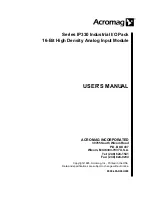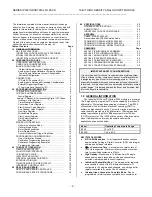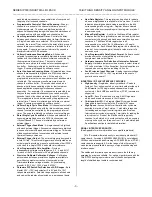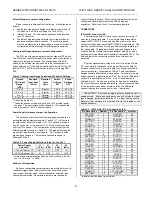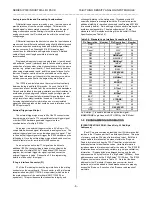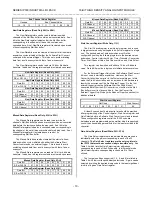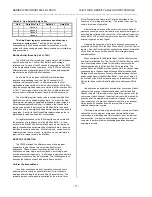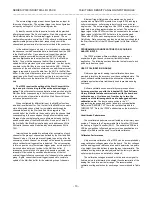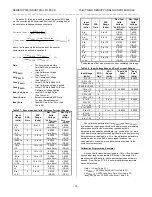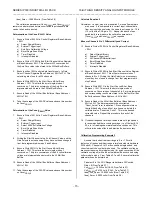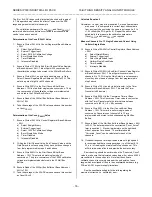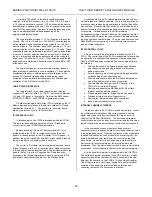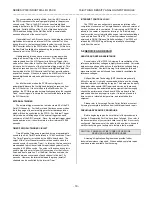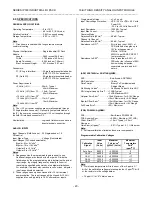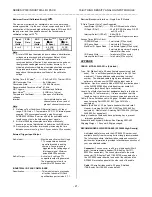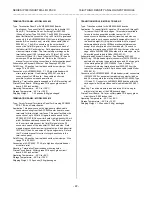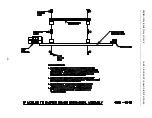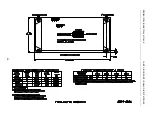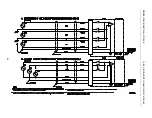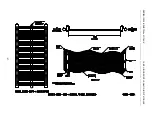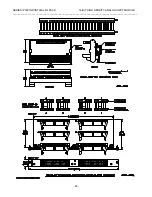
SERIES IP330 INDUSTRIAL I/O PACK 16-BIT HIGH DENSITY ANALOG INPUT MODULE
___________________________________________________________________________________________
- 13 -
The external trigger signal must be configured as an input for
this mode of operation. The external trigger can be configured as
an input by setting bit-2 of the Control register low.
At least 5
µ
seconds of data acquire time should be provided
after programming of the Control register, Start Value register, and
Gain Selects before the first external trigger is issued. These
configuration registers control the IP330 on board multiplexers and
programmable gain amplifier which, respectively, control the
channel and gain selected for the input provided to the converter.
In the external trigger only mode, it is important to understand
the sequence in which converted data is transferred from the ADC
to the Mail Box Buffer. Upon an external trigger the selected
analog signal is converted but remains at the ADC while the
previous digitized value is output from the ADC to the Mail Box
Buffer. Thus, with this sequence the Mail Box is consistently
updated with the previous cycle’s converted data. In other words,
new data in the Mail Box is one cycle behind the ADC. With this
sequence, at the end of data conversions, one additional external
trigger is required to move the data from the ADC to the Mail Box
buffer. At the start of data conversion, with the first external trigger
signal (given the Start Convert Bit is set), data is not input to the
Mail Box buffer since the data in the ADC buffer is old convert
data.
The IP330 requires the setting of the Start Convert bit to
logic one prior to receiving the first active external trigger
pulse.
This will prevent erroneous data from being written into the
Mail Box Buffer corresponding to the first channel converted. This
is the only mode of operation in which the Start Convert bit does
not cause data conversions.
When configured for differential input, the Mail Box functions
as a dual level data buffer. The first half of the Mail Box is used to
store all selected channel data for the initial pass through the
channels defined by the Start and End Value registers. The
second half of the Mail Box is then used to store the channel data
corresponding to the second pass though all selected channels.
Storage of channel data continues to alternate between the first
and second halves of the Mail Box Buffer. As seen in Table 3.2,
the first half of the Mail Box is defined by word addresses 40H to
5EH while the second half is defined by word addresses 60H to
7EH.
Interrupts can be enabled to activate after conversion of each
channel or the group of channels as defined by the Start and End
Channel Values. If interrupts are configured to go active after the
conversion of each channel, an interrupt will be issued 8
µ
seconds
after a valid external trigger pulse is detected. The only exception
to this is upon the very first external trigger pulse, no interrupt will
be issued since data is not written to the Mail Box buffer. If
interrupt upon completion of a group of channels is selected, an
interrupt will be issued 8
µ
seconds after detection of the first
external trigger following conversion of all channels in the selected
group. Again, one extra external trigger is needed to complete
update of the Mail Box buffer for the selected group of channels.
External Trigger Only mode of operation can be used to
synchronize multiple IP330 modules to a single IP330 running in
uniform continuous, uniform single, burst continuous, or burst
single mode. The external trigger, of the IP330 running uniform or
burst mode, must be programmed as an output. The external
trigger signal of that IP330 must then be connected to the external
trigger signal of all other IP330s that are to be synchronized.
These other IP330s must be programmed for External Trigger
Only Mode. Data conversion can then be started by writing high to
the Start Convert bit of the IP330 configured for Uniform or Burst
mode.
PROGRAMMING CONSIDERATIONS FOR ACQUIRING
ANALOG INPUTS
The IP330 provides different methods of analog input
acquisition to give the user maximum flexibility for each
application. The following sections describe the features of each
and how to best use them.
USE OF CALIBRATION SIGNALS
Reference signals for analog input calibration have been
provided to improve the accuracy over the uncalibrated state. The
use of software calibration allows the elimination of hardware
calibration potentiometers traditionally used in precision analog
front ends.
Software calibration uses some fairly complex equations.
Acromag provides you with the Industrial I/O Pack Software
Library diskette to make communication with the board and
calibration easy. It relieves you from having to turn the
equations of the following sections into debugged software
calibration code.
The functions are written in the “C”
programming language and can be linked into your application.
Refer to the “README.TXT” file in the root directory and the
“INFO330.TXT” file in the “IP330” subdirectory on the diskette for
details.
Uncalibrated Performance
The uncalibrated performance is affected by two primary error
sources. These are the Programmable Gain Amplifier (PGA) and
the Analog to Digital Converter (ADC). The untrimmed PGA and
ADC have significant offset and gain errors (see specifications in
chapter 6) which reveal the need for software calibration.
Calibrated Performance
Very accurate calibration of the IP330 can be accomplished by
using calibration voltages present on the board. The four voltages
and the analog ground reference are used to determine two points
of a straight line which defines the analog input characteristic. The
calibration voltages are precisely adjusted at the factory to provide
optimum performance, as detailed in chapter 6.
The calibration voltages are used with the auto zero signal to
find two points that determine the straight line characteristic of the
analog front end for a particular range. The recommended
calibration voltage selection for each range is summarized in Table
3.7.

